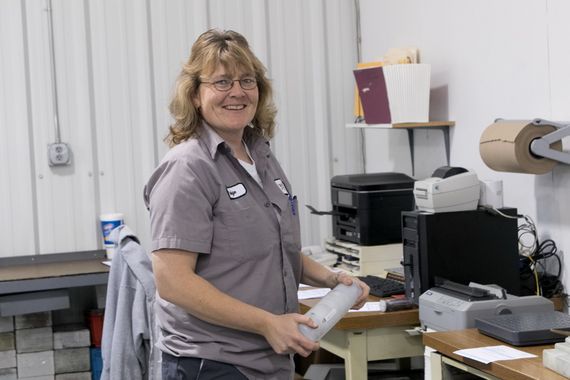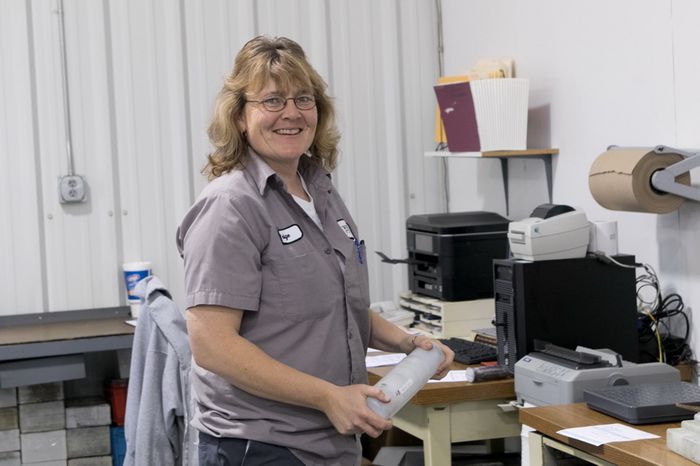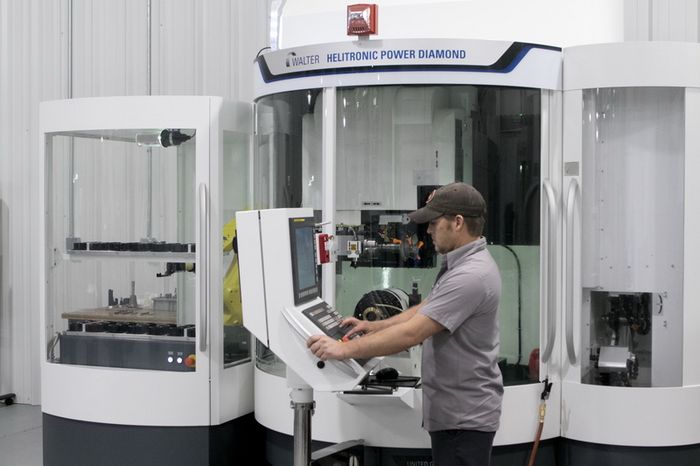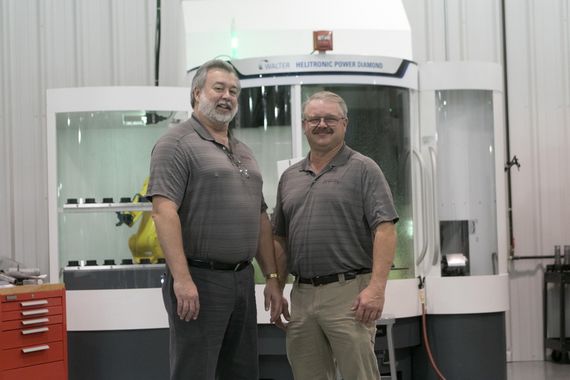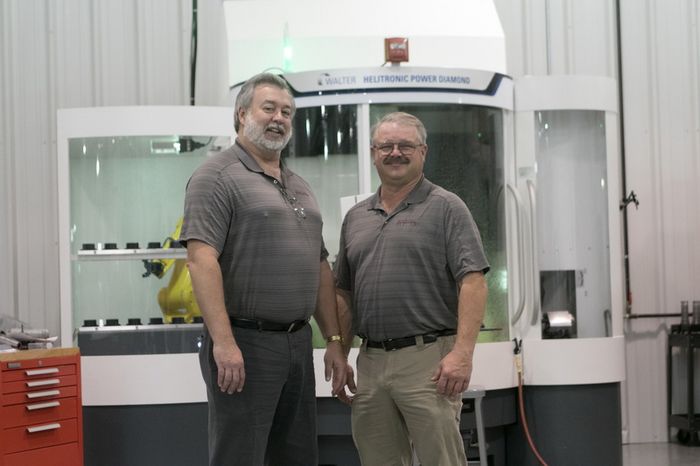Shop Grinds a Successful Niche in Specialty Tooling
There was a time when all the polycrystalline diamond (PCD) material cut and brazed on to solid-carbide cutting tool blanks came in planar forms. These thin flat, round disk-shaped pieces of raw material, however, severely limited tool-design/grinding shops in terms of the cutter geometries they could produce.
Fortunately for West Ohio Tool Co. in Russells Point, Ohio, and the rest of the toolmaking industry, the last decade or so has ushered in new and various shapes of raw PCD as well as innovative ways of inserting the material into solid-carbide cutting tool blanks. As a result, West Ohio Tool now designs and can produce much of its specialty tooling from raw materials featuring helical veins of PCD, cross-center tips of PCD or in grooves with sandwich pieces of PCD within them.
Tools from West Ohio Tool provide customers, such as those in the aerospace and automotive industries, outstanding performance and up to 40 percent longer tool life than standard cutters. In some instances, the shop’s specialty tools can run for years before ever needing to be resharpened. For instance, one of the company’s diamond cross-center tip drills generated more than 676,000 holes over a four-year time span and continues to go strong.
This type of specialty tooling, according to Kerry Buchenroth, owner and founder of West Ohio Tool, would be impossible to develop without the variety of raw PCD shapes available today and the expertise of his tool designers. In terms of the quick and cost-effective manufacture of these tools, he said only the most advanced, high-precision CNC tool grinding/eroding technology will do.
From its humble beginnings in a barn in 1989, West Ohio Tool’s CNC tool grinders have all been WALTER and EWAG systems from UNITED GRINDING. The machines not only allow the shop to generate its complex tool geometries and surface finishes, they also deliver a high level of processing ease and flexibility to accommodate constantly changing customer needs.
The shop has eight grinding systems from UNITED GRINDING: seven WALTER 5-axis grinders, an EWAG PCD grinder and a HELICHECK CNC inspection and measurement system. For fast and easy programming, the two newest grinders feature WALTER’s HELITRONIC Tool Studio software.
Among the shop’s newest machines is the WALTER HELITRONIC POWER DIAMOND two-in-one system that performs grinding and electrical discharge machining (EDM). With copper rotary erosion/electrode wheels, the machine EDMs the PCD portions of tools, then conventionally grinds the carbide areas. West Ohio Tool was the first shop in North America to acquire this most recent version of the HELITRONIC POWER DIAMOND, and according to Buchenroth, the machine represents a huge leap in tool production.
Diamond/PCD is tough to grind, and the only wheels available to grind it are those made from diamond. Unfortunately, the scenario creates a one-to-one grinding ratio, meaning the grinding wheel wears equally to the amounts of part material it is removing, which makes the process costly.
Because manmade diamond (PCD) has cobalt present within the diamond layer, the material is conductive and therefore well suited for the EDM process. This type of machine capability, along with combined advances in brazing and PCD materials, West Ohio Tool is able to create new products and solutions not possible in the past.
The fully automated HELITRONIC POWER DIAMOND provides complete machining in single clamping cycles. It changes from grinding to eroding, or vice versa, on-the-fly and automatically. In addition to PCD and carbide, the machine processes tools from high-speed steel, cermet and ceramics in diameters from 3 to 320 mm, lengths up to 350 mm and weights as heavy as 50 kg.
The machine’s robot improves accessibility to workpieces and makes special applications possible. Depending on the workpiece type or diameter, up to 3,500 parts can be loaded using the robot.
“Unlike large catalog-type tool suppliers that tend to concentrate on higher volumes of simple mass-produced standard items such as inserts, we focus on the low lot size specialty jobs involving complex tools,” explained Buchenroth. “We create completely special tools, as opposed to simply modifying standard ones and calling them ‘specials’. Naturally, our tools require a bit more design and manufacturing effort and thus can be more expensive. But, they are capable of running at higher feedrates, increased cutting speeds and have longer tool life that results in lower overall processing costs for our customers.”
Because West Ohio Tool is an all-specials shop, its job runs are typically five to 25 pieces, with the occasional couple-hundred-piece jobs. And, many of the productivity enhancing tools the shop designs are those that perform multiple operations — for example, a tool that spot drills, drills and countersinks all in one. The shop often meets with customers and designs tooling around part drawings, 3D models or the actual parts.
According to West Ohio Tool Co.’s VP of Operations Scott Ries, the Tool Studio software on the WALTER machines is extremely critical to the shop’s tool design efforts and production speeds. Without it, due to the highly complex tool geometries the shop produces, his operators would spend substantially more time programming on older software versions which utilize G and M codes.
The Windows-based software allows the shop to simply fill in the required information fields and run the job. But most useful, according to Ries, is the software’s 3D simulation capabilities.
“Simulation is a great advantage, especially with our newest WALTER machine,” said Ries. “We can simulate both the grinding and the electrical discharge erosion processes, and, with Tool Studio, what you see in the simulation is what you get. There’s no going back and forth grinding a tool close, checking it, then grinding some more and re-checking. We get instantaneous simulation that we can either run the program from or use to make adjustments using the on screen images.”
He went on to say the simulations streamline communication with customers during the tool design stage to shorten iteration time frames. In the past, the shop had to fabricate an actual tool and send it to the customer for feedback. Now, it designs a tool and exports a 3D concept model then, once approved, uses that model to quickly program the tool in Tool Studio. And the new Tool Studio solution for erosion makes operations possible that were once only available for solid carbide or high-speed tools.
When it comes to automation, West Ohio Tool’s lower lot sizes tend to present a challenge, but the shop automates wherever and however possible. The new HELITRONIC POWER DIAMOND machine has built-in pallet automation with a robot, while other grinders in the carbide grinding area use robot arms and gantry systems. Automation, according to Ries, increases the shop’s output through additional lights-out production and extended shifts.
Also, because of its low lot sizes, the shop is constantly setting up for new jobs and its WALTER and EWAG grinders provide efficient changeovers. To keep the amount of setups in check, West Ohio Tool will, as much as possible, run similar tools or families of tools on the same grinder. For instance, a machine set up for drills will run drills all day — the same wheels but different programs. Often times, the shop will have all of its grinders running drills one week then processing end mills the next. Workflow is dependent on incoming orders and delivery times, added Ries.
The shop’s grinding tolerances are typically between two and five microns. For its diamond tooling, the shop does 100 percent inspection, while the percentage of carbide tooling inspected is usually dependent on batch sizes.
For inspection, the HELICHECK system performs fully automated measurements of complex profiles and shapes on rotationally symmetrical tools and production parts. Well suited for West Ohio Tool’s in-process quality control, the system features a low-vibration, solid granite base that contributes to its certified measuring accuracy of E1 = (1,4 + L/300) μm and repeatability of ≤ 1.0 μm.
While there are myriads of standard tool grinding shops, West Ohio Tool continues to differentiate itself in the specials arena. Being an all-specials shop allows it to expand into markets that use large amounts of specialty tooling. But, according to Buchenroth, the shop must also continue to maintain its cost competitiveness and always strive to further shorten delivery times through the use of the latest in tool grinding technology from UNITED GRINDING.
The shop’s current facility has room for growth, and Buchenroth has his sights set on expanding the company’s national presence. Key opportunities include continued work in automotive and significant expansion into the aerospace sector. The shift to more carbon fiber reinforced plastic (CFRP) and other carbon fiber materials in those industries is a main driving force when it comes to the specialty tooling the shop will produce in the future.




